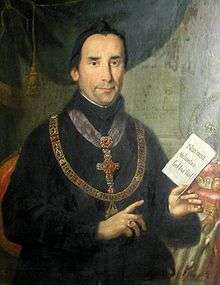Pankraz Vorster
| Pankraz Vorster | |
|---|---|
 Pankraz Vorster | |
| Born |
31 July 1753 Naples, Italy |
| Died |
9 September 1829 (aged 76) Muri, Switzerland |
| Occupation | Swiss-bishop |
Pankraz Vorster (July 31, 1753, Naples – 9 September 1829, Muri) was a Swiss abbot. He served as the last abbot of the Abbey of Saint Gall, from 1796 to 1805.
Early life
Pankraz Vorster was born in Naples to an old family from Fürstenland. He was the son of Captain Joseph Zacharias Vorster and Countess Anna Maria Rosa Berni. He was raised mainly by his uncle, who was a pastor in Grub and Wittenbach. In 1771, he completed his studies in St. Gallen. He taught Philosophy, Science and Theology at a school.
Priest
On July 13, 1777, he was ordained as a priest. In 1784, he undertook a study trip with Johann Nepomuk Hauntinger to Swabia and Bavaria. In 1785, he led the opposition against Abbot Beda Angehrn. In the eyes of some monks he threatened the monastery's large investments and its autocratic administration. He was penalized and was moved in September 1788 as suboeconomus (vice governor) to Ebringen, a St Gall domain under Austrian suzerainty south of Freiburg im Breisgau. In 1796, Vorster reconciled with Angehrn and returned to St. Gallen.
Abbot
On June 4, 1796, Vorster was elected abbot and supported the efforts for democracy in the monastery's dominions. In 1797, he conceded the region its own seal and ancient right of choice of a magistrate. On February 3, 1798, the chapter arbitrarily granted its subjects their independence, ending the monastery's secular rule. The previous Vogt of the Abbey in the County of Toggenburg, Karl von Müller-Friedberg, had arbitrarily dismissed the Counts of Toggenburg to independence on January 1. On February 14 in Gossau, the Constituent Landsgemeinde of the "Republic of Free St. Gallen" met. Vorster moved to Neu-Ravensburg, an exclave north of Lake Constance, and formally raised a protest against his subjects' action on March 3, 1798.
Exile
After the invasion of France, Vorster tried in vain to remove the Abbey from Switzerland with a proclamation on June 9, 1798, so as to rejoin the Holy Roman Empire. With the arrival of the troops of the coalition in St. Gallen, Vorster returned to the monastery on May 26, 1799, and began to rebuild the Dominion. He had to flee again on September 29 to Mehrerau after the defeat of the coalition in Zurich.
Vorster exiled himself to Ebringen, in Austria's sphere of influence, which became the monastery's last ruled territory. From there, he worked continuously for the recovery of his monastery. He refused all offers to restore the monastery without sovereignty. In 1803, he sent an emissary to the Helvetic Republic and to the Consulta in Paris, to seek Napoleon's support for the restoration. The Act of Mediation decreed that all monasteries should be restored. However, Karl von Müller-Friedberg prevented restoration for St. Gallen because of Vorster's extensive demands and because the newly established canton would have endangered St. Gallen. Instead, Vorster received St. Gallen from the bishop of Basel, Franz Xaver von Neveu, on November 4, 1804 in Offenburg,. Months later, the Great Council of the Canton of St. Gallen on May 8, 1805 approved the monastery's liquidation. Vorster left Ebringen in September 1805 to Vienna. Vorster was called "the gravedigger of his monastery" because he prevented any compromise.
In 1814-1815 Vorster personally asked the Congress of Vienna to recover his rule, but could only obtain a pension (6000 florins), while the canton retained control of St. Gallen. Vorster unsuccessfully attempted, with the support of the pope, to get the affiliation of at least one Diocese of St. Gallen before the Federal Council at Tagsatzung on July 16, 1816. In the same year he moved to Arth.
Death
From 1819 he withdrew into the Muri Abbey, where he died in 1829. Formally, he remained the abbot of St. Gallen until his death, because from the perspective of the Catholic Church the monastery was only abolished in 1845. In 1923 his body was interred in the St. Gallen Cathedral.
Further reading
- Historisch-Biographisches Lexikon der Schweiz, Bd. 7, Neuenburg 1934, S. 300.
- Alfred Meier: Abt Pankraz Vorster und die Aufhebung der Fürstabtei St. Gallen. Freiburg i.Ue. 1954 (Studia Friburgensia NF 8).
- Werner Vogler: Abt Pankraz Vorster von St. Gallen und der Wiener Kongress 1814/15. St. Gallen 1982.
- Pankraz Vorster, in: Helvetia Sacra III/1/2 (1986), S. 1348–1350.
External links
- Abt Pankraz Vorster (1796–1805) im Stadtlexikon der Stadt Wil
- Pankraz Vorster in German, French and Italian in the online Historical Dictionary of Switzerland.